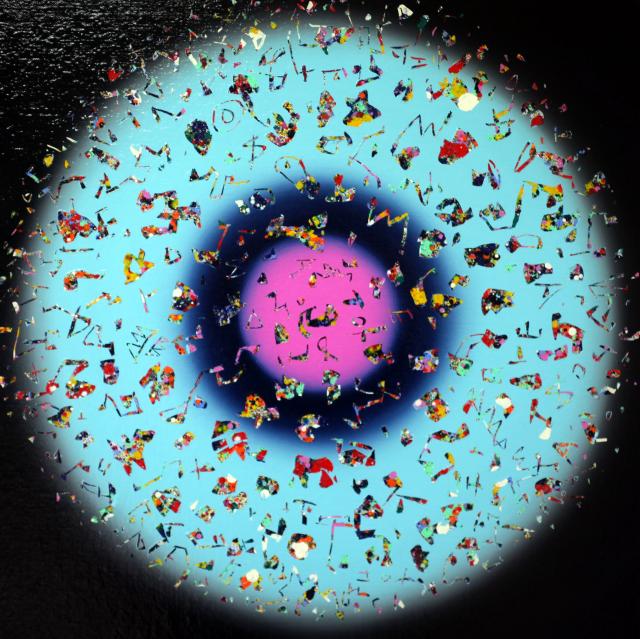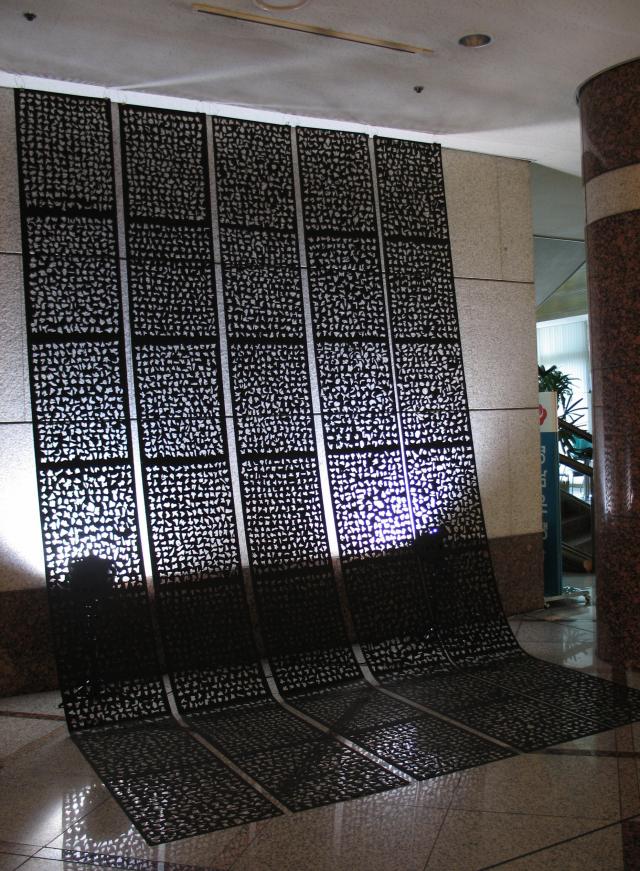Hyun-Su Park Solo Exhibition
English follows
パク・ヒョンス 個展
2018年7月15日(日)~7月28日(土)
15:00~20:00(最終日~18:00) 17日(火)、23日(月)休廊
Opening Reception 7月15日(日)午後5時~
構造としてのキャンバス、輝く空間
- パク・ヒョンスの作品について -
呉光洙(オ・グァンス) 美術評論家
少なくとも20世紀以来、画家はフラット・キャンバスを構造としてどのように解釈するかにこだわってきたといえるだろう。別のいい方をすれば、キャンバスの構造の解釈として、どのような方法が考えられるかを追求していった。ここでの優先事項は、コンテンツ(表面のイメージ)自体ではなく、フラットなキャンバス構造上のコンテンツを確実に伝達する方法なのだ。
その意味で、朴賢秀(パク・ヒョンス)の作品は、キャンバスを構造物として解釈するものとみなされなければならない。彼の作品のユニークさは、キャンバスの深さと広さの両方によって形成される二重構造から来ている。パクのキャンバスは絵画の一般的な文脈を超えた新鮮なパラドックスを放つ。このパラドックスは、深さと広がりが共に形成される多層構造から来ていることが容易に理解できる。しかし、この2つの要素の単純な対比は、キャンバスの構造化の独自性の唯一の鍵ではない。これとは対照的に、複数のレイヤーとファセットの豊かさが神秘的な輝きをもたらしている。
パクの絵画はぼやけているが精巧で、ダイナミックではあるが非常に静かで、シンプルだが複雑で概念的だが同時に現実的である。彼の作品には、意識と無意識、無作為と細かい審議が共存している。部分と全体の両者が複雑な順番で統合されながら微妙に断片化されている。目に見えるものと目に見えないものは、キャンバス上で互いに調和して存在している。銀河状のものがキャンバス上の宇宙の奥に深く沈み込む中、化石のようにはっきりと区別できるイメージ像の断片が爆発する。宇宙、あるいは世界の創造は、このように見えたかもしれない。
初めに、神は言葉で天と地を創造したと言われる。たぶん、宇宙の周りに浮かんで宝石のように輝く小さなシニフィアンは、創造のあらゆる瞬間を記録するという言葉に取って代わるものだ。最後に、闇から出てきた輝く光がパクのキャンバスに落ち着き、ユニークな概念的な形をなしている。批評家キム・ヨンホによれば、パクの作品は自然の光からインスパイアされており、芸術的に表現した光を表現する過程で、光の構造と精神を定義する概念的な形態を首尾よく開発している。確かに、この光はパクのキャンバス構造の重要な要素である。また別の批評家ウー・ハクユンは、色彩を明かりに変えた印象派の作家たちとパクの作品は、色を光として再評価し彼らのキャンバスに光のコンセプトを導入した点で共通している、と解説した。しかし、パクの光の解釈は、概念的、精神的なレベルを超え、最終的には宗教的レベルに到達することは直感的には明らかである。彼の作品は最初の記憶を引き出す。光が芸術家に属しているという微妙ないいかただが、これら作品が思い出をつぶやくのが聞こえないだろうか?
パクの作業の進展は、キャンバスを構成する深さとレベルも反映している。最初のステップは、キャンバスを多色の塗料のしずくで塗りつぶすことだ。それから彼は色の層でそれを完全にカバーし、乾燥する前にラバーナイフでキャンバスのいくつかの部分をこする。それらスクラッチのそれぞれは、目立つように現れる。いくつかは韓国のアルファベットのように見えるが、他のものは西洋のアルファベットやアラビア数字のようにも見える。それは、宇宙の周りに浮かぶ星雲の神秘的な化身のようにも見える。ループのバックグラウンドに光の小さな閃光が現れ、キャンバス上に儀式の空間ができあがる。同時にこれらの浮動ループは私たちが知らない世界への旅に私たちを誘う。それらはキャンバスを覆う共鳴に圧倒されてるが、微妙で、同時に秘密の光のささやきをも内包する。この微妙な構造のパラドックス、パクのキャンバスは主に幅の広い単純な幾何学的形状で構成されているが、これらの形状は数百の繊細な断片形態になっている。
彼のキャンバスとその中で生成された無数の粒子の豊かさは常に劇的な効果を生み出し、最終的にこの効果は平らなキャンバスを越え、現実界に到達する。作者は、その現実のドラマを受け入れ、解釈し、それに固執する方法を見つけ出そうとしているようだ。
--------------------------------------
Hyun-Su Park Solo Exhibition
July 15 sun– 28 sat
15:00~20:00 Last day ~18:00
July 17 tue, 23 mon are close
Opening Reception; July 15 sun 17:00~
The Canvas as a Structure, or a Space of Brilliance
— On Hyun-Su Park’s Work —
Written by Kwang-Su Oh Art critic
It is fair to say that at least since 20th century, painters have been obsessed about how to interpret the flat canvas as a structure. Put differently, they have constantly tried to interpret the structure of the canvas, before thinking about what kind of the image one can bring about on it. The priority here is certainly the way to convey the content on the flat canvas structure, rather than the content itself.
In this sense, the works of Hyun-Su Park have to be viewed as an interpretation of the canvas as a structure, among others. The uniqueness of his works comes from the dual structure formed by both the depth and the extent of the canvas. Park’s canvas gives out a fresh paradox, which goes beyond the general context of paintings. It is easy to figure out that this paradox comes from the multi-layer structure that the depth and the extent form together. However, this simple contrast of two elements is not the only key to the uniqueness of his structuring of the canvas. You have to remember that the richness of multiple layers and facets in contrast brings with it a mystic brilliance.
Park’s paintings are blurry but sophisticated at once, dynamic but extremely still, simple but complex, and conceptual but real at the same time. The consciousness and the subconsciousness, randomness and a fine deliberation co-exist in his works. Both the part and the whole are delicately fragmented while being integrated into a grandiose order. Both the visible and invisible things exist in harmony with each other on the canvas. While the galaxy sinks deep down into the vastitude of the universe on the canvas, the fragments of image that are as clearly distinct as fossils explode on it. The creation of the universe, or the world in the very beginning might have looked like this.
It is said that in the beginning God created the heavens and the earth by his word. Perhaps those tiny signifiants that float around the universe and shine like jewels are there to replace the word in recording each and every instant of the creation. Finally the shining light emerging from the darkness settles on Park’s canvas and becomes a unique conceptual form. According to Young-ho Kim, Park’s works are inspired by the light of the nature, and in the process of artistically expressing the light he experienced, Park has successfully developed his own conceptual form defining structure and spirit of the light. The light, certainly, is the key element of Park’s canvas structure. Woo-Hak Yoon even compares Park with the impressionist artists who converted colors to lights, saying that Park’s works are in line with those of the impressionists who revalorized colors as lights and elevated the absolute value of colors.
There are a lot of contemporary painters who introduced the concept of light on their canvas, and Park is one of them. However, it is intuitively clear that Park’s interpretation of the light goes beyond the conceptual and spiritual level, and reaches eventually the religious level. His works gives out the memories of the very beginning. Don’t you hear these memories whispering in a subtle way that the light belongs to the creator?
Park’s working progress also reflects both the depth and the extent structuring the canvas. The first step is to fill the canvas with multi-colored paint drips. Then he covers it thoroughly with a layer of color, and scrapes several parts of the canvas with a rubber knife before it dries. Each one of those scrapes emerges as sparkling signifiants. Some look like Korean alphabets, while others look like occidental alphabets or Arabic numbers. It even seems like a mystic incarnation of the nebulae floating around the universe. Those tiny flashes of light swirl on the background of loops, creating a ritualistic space on the canvas. At the same time, these floating loops take us on a journey to a world that we don’t know. It’s overwhelming with the resonance covering the canvas, but subtle and still at the same time with the secret whispers of light. This subtle paradox of structure can be also put in the following way: “Park’s canvas is mainly composed of vast and simple geometric shapes, but these shapes are in fact a set of hundreds of delicately fragmented forms.”
The vastitude of his canvas and the innumerable particles generated within it create always a dramatic effect, and this effect eventually goes beyond the flat canvas and constantly reaches out to the reality. The author seems obliged to try to figure out the way to accept, interpret and stick to the drama of that reality.
ーーーーーーーーーーーーーーーーーー
Solo Exhibition
2018 Journey to Universe18, Onyou Gallery, Anyang
2017 2nd Jeon Hyeok-lim Art Award Solo Show, Jeon Hyeok-Lim Museum of Art, Tongyeong
2017 Journey to Universe, Hoseo University Gallery, Asan
2014 The Bloom, Ujong Museum of Art, Boseong
2014 Expansion, Gallery Jean, Jean Art, Seoul
2013 Interaction, Artspace, Nam, K Gallery. Seoul
2012 Recent Works, SLG Gallery, SF, USA
2012 Classy Lifestyle with Artworks of Park Hyun Su, Gallery Jean, Jean Art, Seoul
2010 Multiplicity II, Gallery Jean, Jean Art, Seoul
2010 Multiplicity, Dooin Gallery, Seoul
2008 Duality08, Gallery Jean, Jean Art, Seoul
2007 Recent Works, Evolving Art Gallery, SF, USA
2007 Duality, Songeun Gallery, Seoul
2006 Solo, 1212 Gallery, Burlingame, USA
Group Exhibition
2017 Asian Silk Links, Nanjing Univ Museum of Art, Nanjing
2016 Asian Silk Links, Gunagzhou Univ Museum of Art, Gunagzhou
2016 RESTART, Gallery Chosun, Seoul
2016 The Thousand Towers, Gwangju Museum of Art, Gwangju
2016 The Scale of Dragon, SAC(Seoul Art Center), Seoul
2016 The Line World, Baekmin Art Museum, Boseong
2015 Midfielder, Gallery Wool, Gao Yang
2015 Yesterday & Today,Gwangju, Gwangju Museum of Art, Gwangju
2014 Conversation, Yangpeong Art Museum, Yangpeong
2014 Chung-Ang Contemporary Art Festival, Kepco Art Center, Seoul
2014 The Eyes of Asia, Baekmin Art Museum, Boseong
2013 Midfielder-GMA Gallery, Seoul Annex of Gwangju Museum of Art. Seoul
2013 醉畵之節(Intoxication by Paintings)- Gallery K, Seoul
2013 Mt. Mudeung+Dream- Evergreen Hall of Gwangju Museum of Art, Gwangju
2013 hyeongsaegjigyo, Gallery K, Seoul
2013 Korea contemporary Art-TOP ART, GMA Gallery, Seoul Annex of Gwangju Museum of Art. Seoul
2012 Gwangju Art Award Awardees Exhibition - Art Museum of Woo Jae Gil, Gwangju
2012 Dream-Daily routine of Nam-do, Art Museum of Oh Seung-woo in Muan-gun, Muan
2011 Room of Meditation, OCI Museum, Seoul
2011 TOP 2011 Exhibition, Insa Art Center, Seoul
2011 'We suggest this 31 Artists', Gallery Wood, Seoul
2011‘The 3', 123 Gallery, Seoul
2011 Mujin Exhibition, Gongpyeong Art Center, Seoul
2011 Dong River contemporary Artist Invitation Exhibit, Yeongwol Culture&Art Center, Yeongwol
2010 CHINA KOREA MODERN ART FAIR, 798 Gallery 706 Hall, Bijing, China
2009 The Scale of Dragon, SAC(Seoul Art Center), Seoul
2009 Korea&Japan artist Artists Exhibition, Gallery Jean, Seoul
2008 Korea Elite Artists Invitation Exhibit, Anshan Arts Center, Anshan
2008 Timely Interjection', Gallery Chosun, Seoul
2008 Invitation Exhibit for 32 Contemporary Artists, Limlip Museum, Gongju
2007 PCAB(Pocheon Asia Biennale) Special Exhibition, Pocheon
2006 MM06, San Jose Institute of Contemporary Art, San Jose, USA
Collection
2016 Gunagzhou Univ Museum of Art, Gunagzhou
2015 Yangpeong Art Museum, Yangpeong
2015 Ujong Museum of Art, Boseong,
2013 Gwangju Museum of Art, Gwangju
2012 National Museum of Modern and Contemporary Art in Government Art Bank, Seoul
2011 OCI Museum, Seoul
2010 SEMA, Seoul, Seoul
2009 National Museum of Modern and Contemporary Art Art Bank, Seoul
2008 San Jose Art Musm, San Jose, USA
2007 Yonsei Univ. Samsung Digital Library, Seoul




